

|
Archive for the ‘Adventure’ Category
Thursday, October 30th, 2008
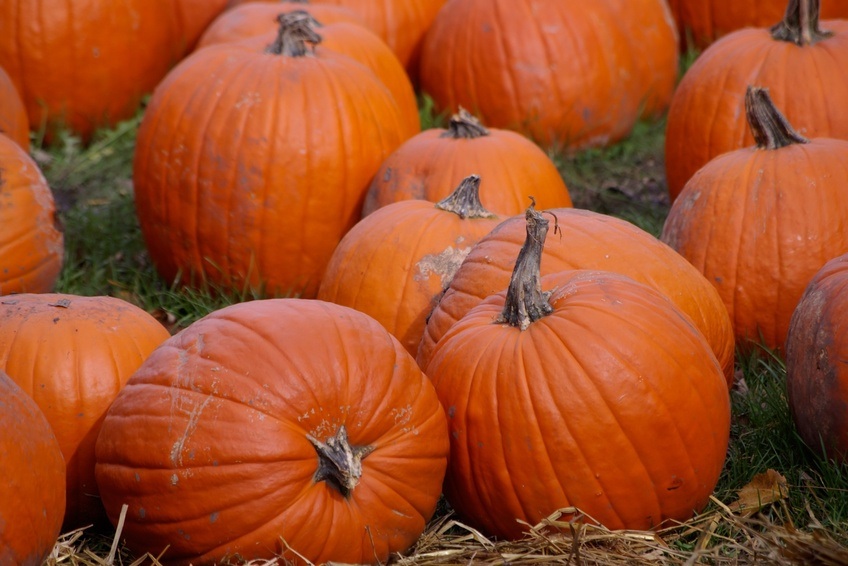
P.S. Yes, I know the postscript normally goes at the end, but just in case you don’t make it that far, I want you to know there’s a great recipe awaiting you. Yum!
As seems to be my pattern, I’m barely getting my October post of seasonal foods in under the wire. I figured since tomorrow is Halloween, I’d start with pumpkins, which are incredibly nutritious. However, we all have our culinary limits and one of mine is that I refuse to wrestle with a pumpkin. I’m over it. I organized and managed too many pumpkin carvings when my kids were little. Now I prefer using organic canned pumpkin. It’s so much easier to open a can than it is to dig out the flesh from a whole pumpkin.
Most (99%) of pumpkins used in the US are for jack-o-lanterns. These are those big stringy-type pumpkins that work best as a launching pad for little-kid art. Or big-kid pranks. The smaller “Sugar Pumpkins” are a much better choice for cooking (if you really want to do that). I spend a lot of time in the kitchen because eating healthy gluten-free food is a priority to me, but in this case, I’m going for quick and easy, especially since many of the canned choices are so good. (Recipe for pumpkin buckwheat pancakes to follow.)
Pumpkin is rich in fiber and full of beta-carotene, which is converted to vitamin A in the body. Beta-carotene can be found in orange colored veggies like squash, carrots, sweet potatoes, and pumpkins. It supports eye health and may even help protect against cancer and heart disease.
Raw pumpkin seeds are one of my favorite things to add to granola, trail mix, hot cereal, power bars, wild rice, or to toss on fresh salads. They were considered a medicinal food by Native Americans and although the Indians didn’t know the sciency details, they were right — the seeds are a rich source of zinc, which supports healthy immune function and promotes bone mineral density.
Hey guys, pumpkin seeds also contain phytonutrients called cucurbitacins, which help keep your boy parts running smoothly. Studies show this substance to be beneficial to prostate health, so keep that in mind next time you reach for a snack. And get this, pumpkin seeds are also a concentrated source of protein, so skip the high-fat, high-sugar candy bars and go for a handful of pumpkin seeds instead.
More seasonal foods for October
Apples (for more information on the health benefits of apples, check this post).
Lima beans (butter beans) are an excellent source of fiber, which can help lower cholesterol and promote balanced blood sugar levels. For more information on fiber and the gluten-free diet, check this post.
Onions are a staple in my kitchen. I love grilling onions, which have been a regular part of my CSA box of veggies lately. Onions are a true super food as they’re an excellent source of vitamin C, folate, fiber and contain an important phytonutrient called allicin, which may help lower cholesterol and blood pressure. Plus, onions add wonderful flavor to almost any dish.
Kale (for more information on the health benefits of kale, check this post).
GF/DF Buckwheat Pumpkin Pancakes
what you need
• 1 cup gluten-free buckwheat flour*
• 1 & 1/2 tablespoons pure maple sugar*
• 1 & 1/2 teaspoon baking powder
• 1/2 teaspoon baking soda
• 1 teaspoon cinnamon
• 1/4 teaspoon allspice*
• 1/2 teaspoon ginger powder
• 1/4 teaspoon salt
• 1 &1/3 cup brown rice milk
• 2 large eggs, lightly beaten
• 1 teaspoon vanilla
• 3/4 cup canned pumpkin (no sugar added)
• small amount of coconut oil for cooking
what you do
1. Whisk together buckwheat flour, maple sugar, baking powder, baking soda, cinnamon, allspice, ginger, and salt. Set aside.
2. In another bowl, whisk together rice milk, eggs, and vanilla.
3. Pour liquid ingredients over the dry ingredients and blend until combined. Don’t overmix.
4. Gently fold in pumpkin.
5. Pour about 1/3rd cup of batter onto preheated and greased griddle. Flip when the edges of the pancakes fold in and the bubbles pop. Cook until each side is golden brown.
* Make sure your buckwheat flour is GF. Lauren (see comment below) from daringtothrive is right about Bob’s Red Mill. They don’t advertise their buckwheat flour as gluten-free because it doesn’t test out as gluten-free. Buckwheat is naturally gluten-free, but make sure the source you use guarantees that it has not been contaminated.
* I added the maple sugar the first time I made these simply because it was sitting on the counter and there was about 1 & 1/2 tablespoons left in the jar. I add a little to the mix when I make up my own pre-packaged hot cereal for backpacking. It’s great when you’re out in the wilderness and you want a nice sweet bowl of hot cereal before you hit the trail. Maple sugar is expensive, so don’t run out and buy some just for these pancakes. Leave it out or substitute something else.
* If you don’t have allspice, use a pinch of nutmeg.
These pancakes are so good! You can save the extras, freeze and pop in the toaster later. They also make great hiking snacks.
Happy Halloween!
In good health,
Melissa
Friday, September 26th, 2008

Autumn is harvest time and I’m getting a load of wonderful fruits and vegetables with my weekly CSA delivery. This time of year also ushers in change, and what better way to embrace this change than to focus on nature’s abundance and our own health. Michelle at theaccidentalscientist is hosting this month’s Heart of the Matter blogging event (HotM). The fall theme is Protecting Your Heart While Preserving the Harvest. Check Michelle’s blog next week for a round-up of recipes from this tasty little subculture of heart-healthy food bloggers.
I love having nutritious snacks on hand when I’m out on the trail, but it’s next to impossible to cart around fresh fruit in a backpack. Plus, I like to bring food that is light-weight and easy to stuff into a pack.
Dehydrated apple slices have become a favorite of mine. Remember that old saying — an apple a day keeps the doctor away?
Well, your grandmother was right. Apples are full of antioxidant flavonoids, boasting a very high concentration of quercetin, catechin, phloridzin, vitamin C, and chlorogenic acid. Trust me, those are all good things. Apples also contain both insoluble and soluble fiber (for a detailed explanation of fiber, check here). The insoluble fiber in apples helps ferry out the bad cholesterol (LDL) hanging out in your digestive tract. The soluble fiber helps get rid of LDL produced by the liver. Both of these actions reduce your risk of heart attack and stroke by lowering total cholesterol levels. Studies show people on high-fiber diets have less coronary artery disease than people on low-fiber diets. If that’s not enough, the flavonoids (especially quercetin) demonstrate significant anti-inflammatory ability that protect our arteries. Many of these heart-healthy substances are in the skin, so eat the whole thing, skin and all (not the seeds as they contain some toxic compounds).
Don’t substitute apple juice for the real thing or you’ll lose the majority of antioxidants. It’s always best to go back to the source. Fresh is better, but when you have an abundance of apples and you want to save some for later, dehydrating is a good way to do it. This method doesn’t subject food to the same high temperatures that canning or processing does, so the nutrient value is much better.
dehydrated apples
* These dehydrating times and temperatures are based on my store-bought Excalibur Dehydrator. Times and temperatures may vary.
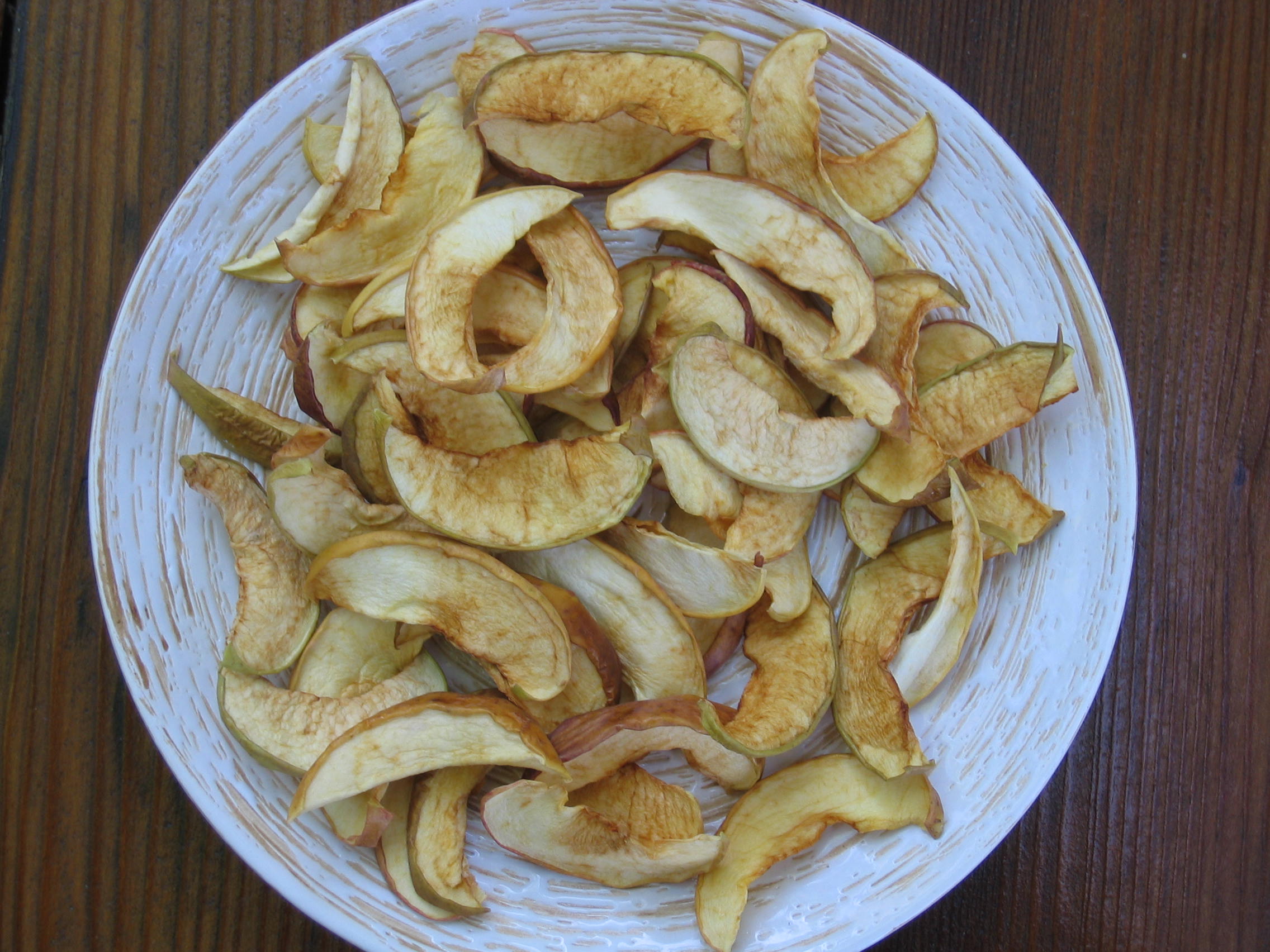
what you need
several washed, cored and thinly sliced apples
lemon juice or vitamin C ascorbic acid to prevent over-browning (this isn’t necessary, but it does make the apple slices look a little better)
what you do
soak apple slices in vitamin C bath for 10 to 15 minutes
drain and place on dehydrator trays according to manufacturer directions
temperature: 135 degrees
time: 7 – 8 hours until leathery
place in tightly sealed ziplock bags and store in cool, dark place
Stick to that apple a day rule and you’ll cut your risk of heart disease.
Enjoy!
Melissa
Sunday, September 7th, 2008

Tell me, what is it you plan to do with your one wild and precious life? — Mary Oliver
I definitely plan to finish the second half of the Colorado Trail. That is at the top of my “things I absolutely HAVE to do during my one wild and precious life” list. Hopefully I can finish it next summer as work and family responsibilities have put completion of our journey on hold for now. My son and I recently finished the first half of the CT — from Denver to a trailhead between Buena Vista and Salida. We backpacked close to 250 miles and trudged up (and also down) some 37,000 feet of elevation gain.
That’s a lot of ups and downs. In a variety of ways and for a variety of reasons. Our trek took us through four different wilderness areas and over several mountain ranges. In addition to a variety of terrain, we experienced all kinds of weather as well — including sun, rain, sleet, hail, and even snow. We also inadvertently timed our travel through the Mt. Massive Wilderness area during the Leadville 100 Mountain Bike Race and ended up having to spend the night at a hotel in Leadville (aaahhh, nothing like a warm shower and a soft bed). Lance Armstrong competed in the event, which is intense to say the least. It’s a 100 mile off-road mountain bike race with what is described as “steep climbs and serious descents.” No kidding! The start and finish is in the heart of the small mountain town of Leadville, CO (elevation 10,200 feet). Fifty miles out and back with a turnaround point at 12,600 feet makes this race pretty dang extreme. After 100 miles, Lance was second by less than 2 minutes! How does that happen? Two minutes after 100 miles of mountain bike racing? And there were hundreds of entrants.
There’s also a Leadville 100 Ultra Marathon which is billed as the “Race Across The Sky” and considered one of the toughest distance races on the planet. It was held the following weekend. Starting at 4 AM, with most of it on the Colorado Trail and the Continental Divide Trail, it’s a true high-altitude, hard-core distance race. To make it even more interesting, this year runners experienced rain, wind, lightning, marble-sized hail, and snow during their 100 mile marathon. Almost sixty percent of the entrants didn’t finish. They’ve been doing this race for 26 years now and they never cancel because of the weather. Hardy souls indeed.
But I digress…
We experienced some of the same weather during our journey, but at least we were in our sleeping bags and tents at 4 in the morning and we didn’t have to cover more than about 12 to 15 miles a day. Some longer days, some shorter days.
Spending that much time in the wilderness allows for hours and hours of time to think, reflect, figure things out, day-dream, re-figure things out, make up endings to stories, sing Johnny Cash songs, wonder what that noise was, think about food, learn to whistle, re-re-figure things out, and have long annoying conversations with yourself. And on it goes, day after day. No money to deal with, no bills to pay, no TV to watch, no phone to answer, no email to check, no newspaper to read, no gas to pump, no purse to dig through, no mirror to look into, no BlackBerry to obsess over (not that I have one). Going back to the basics is incredibly cleansing. I highly recommend it.
Now I’m in the midst of putting together my backpacking meal recipes, sport-specific nutrition information, dehydration tips, and instructions on how to prepare and pack your own food for the backcountry. Most prepackaged backpacking foods contain gluten or other allergens and most companies can’t guarantee that their food is gluten-free, even when there are no obvious gluten-containing ingredients. Most of those foods either use gluten as a filler or prepare their foods on equipment that also processes foods containing gluten. The last thing I want is to get sick while backpacking. No time to have stomach issues. Or achy joints. Or be overly tired. Or have trouble sleeping. Or have headaches.
Well, you get the idea. That’s why I felt it was important to make and prepare all my own food. That way I was able to balance my nutritional needs for exactly what I was doing — this means eating strategies for all-day energy, what to eat when you need a boost to make it up and over the pass, and how to adequately recover so you can start all over again the next day. I’m interested in sport-specific nutrition and how to maximize performance and stay healthy at the same time. I’m thinking a book is in my future. Wish me luck.
In the meantime, here’s a photo wrap-up of our trip, with a reader contest to top it off.
Next week I’ll get back to regular posting with nutrition tips, recipes, and whatever else comes to mind. Does anyone have a topic they’d like me to focus on? Something you might be confused about or interested in? Leave me a comment indicating what’s on your mind and I’ll pick one of the topics and write a specialized post on it.
Sugar? Omega 3s? Antioxidants? Caffeine? Coffee? Sports drinks? Boosting immunity? Strong bones? Wine?
Let me know.
  
Photo #1 — Melissa filtering water (a wilderness woman’s job is never done).
Photo #2 — Columbine, the Colorado state flower.
Photo #3 — Breckenridge Ski Area way in the distance.
  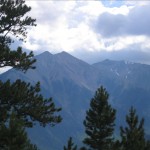
Photo #1 — I became obsessed with taking pictures of signs along the trail. Some were interesting, some informative, some just plain funny. These little “thumbnail” versions of my photos aren’t great, so I doubt you can see this very well, but it says, “Colorado Trail & Tennessee Pass” with an arrow one direction, then it says “Old Mine” with an arrow the other direction. Who knows where the old mine is as we had just come from that direction and never saw one. Hmmm?
Photo #2 — Very old CT sign, with an awe inspiring back-drop.
Photo #3 — Big mountains.
 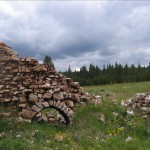 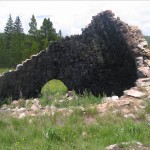
Does anyone know what this is? Keep in mind, this “find” was out in the middle of nowhere along the Colorado Trail. The first person who knows the answer gets a prize. Take a guess!
And don’t forget to get out there and enjoy your one wild and precious life!
In good health,
Melissa
Wednesday, August 13th, 2008

One-hundred and sixty miles down. Three-hundred and forty to go.
We’re one-third of the way through our trek of the Colorado Trail. Depending on what you read, the trail covers anywhere from 485 to 500 miles — from Denver to Durango — with a total elevation climb of 77,690 feet. As I said in the first post I did on the Colorado Trail, that’s a LOT of uphill. We’re now on a 200 mile section of the CT that shares the same footpath as the Continental Divide Trail, so we’re spending more and more time above 10,000 feet, often in alpine zones above timberline.
I’m cooking and dehydrating all our dinners and we’re eating well. And gluten-free, of course. In fact, I have chicken, quinoa noodle, and veggie soup in the dehydrator as I type. With chile con carne waiting in the wings.
Rather than ramble on about the trip, I’ll share some photos with you instead. I’m in a pinch for time, but when things slow down, I’ll get back to posting on a more regular basis. For now, here’s a preview of where I’m spending so much of my time lately. Although the days are long and tiring, there’s nothing more rejuvenating than spending time in the wilderness. No phones, no money, no traffic, no silly TV shows. I love it!
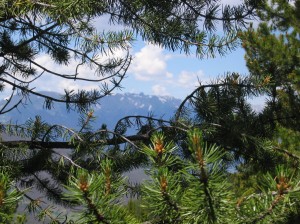
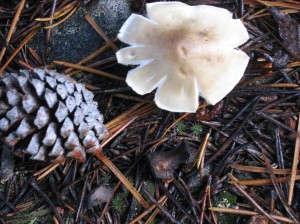


If that waterfall hadn’t been so dang cold, I would have taken a shower — with all my clothes on. They needed washing as much as I did. I won’t even mention how my hair looks after a week of backpacking, although bad hair days aren’t a big deal when all you see during the day is your hiking partner, a few marmots, and a couple of deer.
Onward . . .
Melissa
Sunday, July 20th, 2008

Seventy-five miles down. Four-hundred and twenty-five to go.
The Colorado Trail is our state’s premier long-distance trail. It wanders 500 miles from Denver to Durango. Trekkers experience eight mountain ranges, seven national forests, six wilderness areas, and five river systems while on their journey. There are 28 segments with a total elevation gain of 77,690 feet. Yes, you read that right. Seventy-seven-thousand. That’s a lot of traipsing uphill. There’s also 76,210 feet of descent, so it’s an up and down journey, to say the least.
There are 54 “official” peaks in Colorado that rise above 14,000 feet in altitude and almost two-thirds of them are within a 20-mile radius somewhere along the CT. That makes for some awe-inspiring vistas while pounding out the miles. Much of the trail is at or above 10,000 feet, with two-hundred miles of it skirting the Continental Divide. The trail highpoint is above 13,000 feet in the San Juan Mountains, where we’re likely to find snow well into August this year. We got dumped on this past winter and the snow lingers long into summer in many places.
  
On July 12th my son and I started our hike of the CT at the Waterton Canyon trailhead, southwest of Denver. We emerged 5 segments later at Kenosha Pass. It took us 6 days to travel 75 miles. I’ve always wanted to thru-hike the CT, but family commitments and personal responsibilities take priority to wandering the wilderness. We plan to piece together as many segments as we can this summer. In a perfect world, we’ll get all 28 in by mid-September.
Oh? There is no perfect world?
Well, we’ll do what we can and be grateful for the opportunity. I’ll keep you posted.
Here’s a brief rundown of our adventure so far, complete with our own version of “Backpacker’s Pantry” foods. We prepared and dehydrated our own nutritious gluten-free dinners, skipping all the additives, preservatives, and gluten fillers that often accompany prepackaged backpacking food. I can’t even begin to tell you how wonderful my GF bison chile mac was after a long day of hiking with a backpack that somehow managed to gain weight with each mile.
Day 1 (segment #1)
Waterton Canyon trailhead to South Platte River
17 miles, 2160 feet of elevation gain (most of it within a 5 mile section)
Dinner: Brown rice with dehydrated pinto beans and green chilies
Day 2 (segment #2)
South Platte River to Colorado Trailhead (FS-550)
11.5 miles, 2200 feet of elevation gain (most of it in the first 5 to 6 miles)
This segment of the CT wanders through an area that was part of a 1996 human-induced wildfire that burned nearly 12,000 acres of the Pike National Forest. The small mountain town of Buffalo Creek was partially destroyed and the natural landscape was changed forever. Twelve years later this once-lush pine forest is home to only a few surviving trees. But life goes on and the emergence of new grasses, small plants, and wildflowers is taking shape in a magical way. It’s actually quite beautiful.
Dinner: Bison chili mac and cheese (YUM!)
  
Day 3 (part of segment #3)
Colorado Trailhead (FS-550) to FS-560
10 miles, 1520 feet of elevation gain
Dinner: Garlic mashed potatoes with spicy chile verde
Day 4 (the last 3 miles of segment #3 and 9 miles into segment #4)
Segment 3 to Lost Park
12 miles, 2800 feet of elevation gain
At about mile 4 we joined an old logging road that was originally built by W.H. Hooper in 1885. He owned a sawmill out in the middle of nowhere. This old rugged logging road went uphill through the forest, making me wonder how the heck these guys were able to manage things like this back in the early days. I found it a grind just hiking up the old rocky dirt road. I can’t imagine actually building the thing. It must have taken a lot of blood, sweat, and tears. And a s**t-load of dynamite!
We entered the Lost Creek Wilderness area and camped along the North Fork of Lost Creek. Beautiful country!
Dinner: Corn chowder, brown rice and red beans
Day 5 (finished last of segment #4, which is about 17 miles total)
Segment 4 to Long Gulch
8-9 miles, some up and down, not sure about the total elevation gain
Since we were only planning to hike around 9 miles on day 5, we decided to take the time to make gluten-free pancakes for breakfast. Plus, we had such a lazy and serene campsite, it felt like the right time to treat ourselves to a nice start to the day. I even made maple syrup out of water and maple sugar crystals. I know, these photos aren’t exactly Gourmet Magazine quality and please just ignore the fact that the small Nalgene bottle holding the maple syrup is filthy.
Dinner: Spaghetti and meat sauce with CSA onions and garlic
  
Day 6 (Segment #5)
Long Gulch to Kenosha Pass
14.4 miles, 1600 feet of elevation gain
It rained most of the day, which didn’t bother us at all. It made for nice hiking as it was much cooler and the rain kept the bugs away. Our final descent down into South Park (yes, that South Park — the one on TV) and the Kenosha Pass trailhead was wonderful. We were ready for a shower, a beer (not me), and a glass of nice red wine (me). We ended up making chicken noodle soup at the Kenosha Pass Campground while waiting for our ride back to Golden. It was a nice start to our journey.
Dinner: Chicken noodle soup with all kinds of CSA veggies
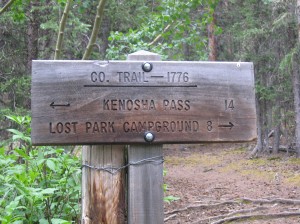
Onward . . .
Go forth and explore,
Melissa
Sunday, June 22nd, 2008
This post will focus on sport-specific fuel for energy — gluten-free fuel no less. Balancing GF food sources for optimal physical performance is easier said than done. In this case, eating and snacking for sustained energy while hiking and backpacking in Colorado’s high country. Fueling up for “peak” performance (bad pun, I know).
But before I launch off on fats, carbs, and protein, I’d like to thank Mike and Adam for giving my blog a spring cleaning and a sweet make-over. Nice job, guys — I love it! As you can see, it’s much more organized, offering an easier way to track down topics of interest.
Onward…
I took this photo about a quarter of a mile into a hike up Mt. Parnassus, a 13,579 foot peak in Colorado’s Front Range. Last week! Yes, it was snowing in mid-June and it came down harder the higher we went. June appears to be the new February, at least around these parts. The point is, be prepared for anything if you’re hiking in the Rocky Mountains. That goes for clothes, snowshoes, ice axes, and food. Well, you might be able to skip the ice axe, depending on where you’re headed. But there’s still a LOT of snow up there this year!
There’s a possibility that I may be taking a long backpack trip this summer, so I’ve been busy dehydrating and preparing my own food since most ready-made backpacking meals are laden with gluten. Yes, it’s everywhere, it’s everywhere! Plus, a lot of the processed stuff isn’t all that nutritious or tasty. I need both. I’m way past the age where I can get by lugging a heavy backpack and plodding along above timberline with a package of Ramen noodles for fuel. Even if they were gluten-free. I need more help than that at this point in my life. No room for error. Not much, anyway.
So, here’s what I need — consistent, high-quality nourishment for long days of hiking; several high-octane boosts when I start wandering up above 12,000 feet; and plenty of recovery fuel. Oh, and lots of antioxidants and essential fatty acids to take care of my very stressed out cells. Think fatigued muscles, sore feet, high-altitude sunburn (hard to avoid, even with sunscreen), strains, scrapes, bruises, and electrolyte imbalances. Sound like fun?
Actually, I can’t think of anything I’d rather be doing on a beautiful summer day than exploring the wilderness, climbing peaks, and traveling in the backcountry. I’ve had a long-standing love affair with nature. But in order to stay healthy, carry a loaded backpack, and do so efficiently and injury-free, I need to eat right and sleep well. That’s sometimes hard to do at 10,000 feet.
I expect a lot from my food. Here’s how and why.
Proper nutrition forms the foundation for physical activity — whether it’s hiking, walking, or playing tennis. Food provides the chemical energy, or fuel, to do mechanical work. Nutrients also provide the essential elements for the repair and maintenance of the body and the synthesis of new tissue, which is very important when you’re running yourself into the ground on a long backpacking trip. Carbohydrates (glucose), protein, and fats are biological fuel. If you want to enjoy your activity, improve your performance, and recover more rapidly, proper fueling is essential.
Glycogen is the body’s version of premium fuel. It’s the principle storage form of glucose (sugar) and is stored in the liver and muscles. Carbohydrates provide the body with glucose, which can be stored as glycogen. Topped-off glycogen levels will increase the amount of time you can hike and will also improve your performance. Or at least prevent stumbling head-on into the “wall.” Or falling off a log into a raging stream. If you don’t refuel while exercising, once the original glycogen stores are depleted, fatigue sets in. Rapidly.
Eating carbs during intense activity will help reserve glycogen stores and provide blood sugar for your brain and muscles to use. Not only do you want to maintain your muscle strength, you also want to think clearly and make good decisions. The higher you go, the harder that gets. Eating the right nutrients and replenishing glycogen stores soon after a hard day in the mountains helps facilitate recovery, helps you sleep better (on lumpy ground while listening for bears) and gets you ready for the next day. Believe me, you’ll be happy you ate well the night before when you roll over in your sleeping bag at 6 AM and have to work the kinks out just to climb out of your tent.
What you eat prior to hitting the trail impacts how your day starts. Regardless of whether you’re hiking a level and well-traveled trail or climbing a mountain, you’ll need to focus on maintaining your energy. And that means doing it day after day if you’re backpacking. Here’s a simplified version of how specific foods are broken down, absorbed, and used by the body. Simple sugars are absorbed fastest, next comes low-fiber complex carbs, then high-fiber complex carbs. Proteins and fats take longer to break down and assimilate, so ideally, you want a mix of these fuel sources. Backpacking requires all aspects of physical activity. Plus, you’re asking your body to sustain the intensity all day. Now add in altitude, hydration issues, and marginal weather, and your fuel needs are major.
Here are some basic principles for maintaining energy and fueling your backcountry diet.
Complex carbs
High-fiber, complex carbs will help you log long hours on the trail. They’re digested more slowly and help maintain consistent blood sugar levels so you don’t crash when you need to pick up the pace if threatening clouds are moving in. Or, you think something is following you in the woods. Brown rice, quinoa, gluten-free pasta, oatmeal, buckwheat pancakes — foods like that should be at least half your trail diet.
Simple sugars
Say you’ve been plodding along at a moderate intensity for 3 or 4 miles. You check your map and suddenly realize you have a substantial climb ahead, what do you do? Other than break down and sob. Your first thought is to stomp your feet, but you quickly realize your boots are too d**n heavy to bother. You need a quick fix and that comes in the form of simple sugars; something that is digested and sent out to your working muscles ASAP. The quicker, the better. Before you cry as your brain slowly translates how closely spaced the contour lines are on your map.
I’m a nutritionist and eat a fairly good diet most of the time. I rarely eat packaged foods, I stay away from processed sugar, and avoid junk foods at all costs. Here is where all rules go out the window. Now is when I grab the power shot or start downing jelly beans. I’d drink cheap maple syrup straight from a BPA-laced plastic bottle at this point if I could. Thank goodness for the fine folks at Clif Bar for coming up with a more manageable and packable version of quick energy. My current favorites are Clif’s Vanilla or Mocha Energy Gels. I also like Whole Foods organic jelly beans. That’s a great thing to keep at your fingertips while hiking (stick a baggy full in your pocket). Pure sugar. Aaahhhh, I love it, especially when facing down a 2,000 foot elevation gain in a short distance. Other good choices are dried fruits, trail mix, chocolate chips, or raisins.
Fat
Fats have been given a bad name, rightly and wrongly so (as I’ve said before). We need good fats for all-day, steady-state energy production. Especially when hiking day after day. Fats also help keep your engine warm on cold nights in the mountains. Healthy fats like nuts are an important part of a backpacker’s diet — and they’re easy to travel with. Salmon jerky, which is high in good fat and protein, is another good food to munch on while hiking. Even sausage and cheese make good trail food. An extended backpacking trip is not the time to go on a low-fat diet, just make sure your choices don’t contain transfats or hydrogenated fats.
Protein
Protein helps repair the muscles and connective tissue you break down during long hikes. Beef jerky, brown rice pasta, quinoa, and teff make great building blocks for muscle and tissue repair. Backpacking stresses your muscles day after day, adequate protein intake will help mitigate that and keep you strong and healthy.
Now go out and explore!
Next time I’ll focus on antioxidants, essentail fatty acids, and electrolytes. I’ll also include a recipe for gluten-free power bars.
In good health,
Melissa
Wednesday, March 12th, 2008
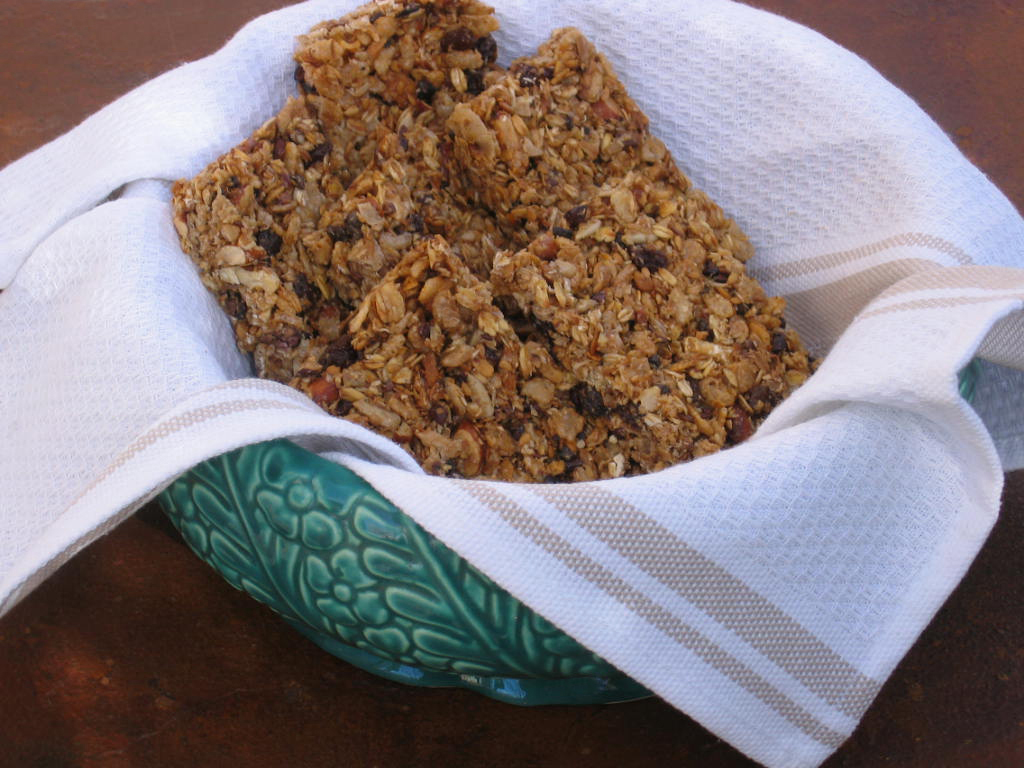
I’m an outdoorsy girl and creating healthy, gluten-free food that travels well in the backcountry is a passion of mine. This energy bar recipe is a take-off from the granola I make, but with several variations.
You can substitute any of these ingredients for something similar. This recipe is just a “launching pad” for whatever you want to come up with. Be creative and play with your food. That makes life more fun, don’t you agree?
Melissa’s Mile High Energy Bars
What you need
• 1 tablespoon coconut oil, olive oil, or butter (to grease the pan)
• 1/2 cup chopped almonds
• 3/4 cup chopped walnuts (or pecans)
• 1 cup GF rolled oats (I use Gifts of Nature’s certified GF rolled oats) * (see below)
• 1 cup Erewhon Organic GF Crispy Brown Rice Cereal (make sure it’s the GF version)
• 1 cup Arrowhead Mills Organic GF Maple Buckwheat Flakes (pulsed in a food processor to a medium chop)
• 3/4 cup finely shredded coconut (I use Let’s Do Organic unsweetened organic coconut)
• 1/3 cup sunflower seeds
• 1/3 cup raisins
• 1/4 cup lightly ground flax seeds (I pulse them a couple times in a small coffee grinder I use
exclusively for seed and spice grinding)
• 1/4 cup honey or agave (agave isn’t as thick, which works better – but either one is okay)
• 1/4 cup pure maple syrup
• 1/4 cup almond butter
• 2 tablespoons cocoa nibs
• 1 teaspoon vanilla
• 1 teaspoon cinnamon
• 1/2 teaspoon sea salt
What you do
Preheat oven to 325 degrees. Grease a 9 x 13 inch baking pan with oil.
Mix chopped nuts, oats, shredded coconut, sunflower seeds, and lightly ground flax seeds and spread out on rimmed cookie sheet. Put in the oven and set timer for 3 to 4 minutes. Watch carefully as this stuff can burn in no time. Stir and reset timer for another 3 minutes. This mixture should be a nice toasted golden color. Adjust according to what works best for your oven. Remove from oven and cool. Mix in a large bowl with the rice cereal, chopped buckwheat cereal, raisins, and the cocoa nibs.
Combine honey (or agave), maple syrup, almond butter, vanilla, cinnamon, and salt in saucepan and bring to low boil over low to medium heat. Stir constantly and let boil for 3 or 4 minutes. You want this thick enough to hold the energy bar ingredients together, but not so thick it’s hard to work with.
Pour over the cereal mixture and stir well to mix it all together.
Spread into your prepared 9 x 13 inch pan, cover, and cool in the fridge before cutting into bar sizes. Store in an airtight container in the fridge. These make great treats for hiking, backpacking, skiing, and life in general!
Enjoy!
* According to the Celiac Sprue Association, oats should be considered with caution. I have used the GF options with no problem, although I don’t eat a lot of them. Apparently some people can’t tolerate even small amounts of GF oats. Here is some current information to help you make an informed decision regarding what would be best for you. If you don’t want to try oats, just substitute something else for that ingredient – no problem.
In good health,
Melissa
Saturday, January 26th, 2008
Remember that tracking contest I had a couple of weeks ago? The little pine marten tracks on my Mary Jane ski post? Well, Janine’s mystery husband guessed right and won the prize. I thought I better show you what he won, so you’d know I followed through on my offer. Hope this techy base layer is keeping the phantom husband/contest winner warm in the Colorado high country!
The next contest and prize will be gluten-free food related since that’s what this blog is all about (with variations), so stay tuned.
Stay warm and healthy!
Melissa


Friday, January 18th, 2008

place: Taos, New Mexico
date: January 18th – 21st
comments: Yippee!



Enjoy your weekend. I’ll be enjoying mine!
In good health,
Melissa
Monday, January 14th, 2008
Surprise – this post isn’t about food, nutrition, recipes, or gluten-free living. But it is about health and well-being. Skiing, hiking, climbing, and wandering the backcountry are just as nourishing to me as a warm bowl of homemade soup. The solitude, peace, and beauty of the wilderness energizes my spirit and calms my soul. I’m a gemini, so you can look at this blog as dual-natured and a bit contradictory. Gluten-free Betty Crocker meets wilderness woman.
Those of you searching for a nice gluten-free bread recipe might want to skip the rest of this post and go directly to my archives file. Or, sit back and enjoy a little glimpse of winter in Colorado’s high country. To get a perspective on this post, refer to my “high country hello and tracking contest” post from last week.
So, what do you guys think? Here is my original photo again, followed by animal tracking information from the Colorado Division of Wildlife. If you’re wondering how this connects to gluten-free living, none of these animals eat wheat, barley, or rye. Not naturally anyway. I’m referring to a species-spanning version of the 6 degrees of Kevin Bacon rule to tie this into gluten-free food. Yeah, I know – it’s a leap.
The question was – What little critter made these tracks? Comment suggestions were snowshoe hare, cotton tail rabbit, or pine marten.


Check out my ski pole grip compared to the tracks. The tracks were small and went from the base of one pine tree to the base of another, which most likely indicates a squirrel, although it could have been a pine marten.
The illustration below shows the tracks left by a snowshoe hare, running through the snow. According to the Colorado Division of Wildlife, mice, rabbits, hares, and squirrels are hoppers, meaning they over-step their front feet with their back feet (think leapfrog), leaving distinct front and rear foot tracks. The back feet are often much larger than the front feet (see below). Although cottontail rabbits and showshoe hare tracks are quite common in the Colorado mountains in winter, the photo I took was not of rabbit or hare tracks since the foot sizes from front to back were so similar. Hares have much larger back feet (6 inches or more). Mice tracks (also hoppers) are often accompanied by a drag line down the middle, left by the tail.

The tracks shown below are from a pine marten. It’s hard to tell from this picture, but they do look a lot like the photo I took. The thing I question is the distance between the front and back tracks. My photo shows them closer together. Pine martens and short-tailed weasels (also called ermine) are bounders.

My guess is that the little guy (or girl) was a squirrel, possibly an Abert or pine squirrel, but since I’m not absolutely sure, the closest (and maybe correct) answer is pine marten and that would be Janine’s behind-the-scenes husband’s answer (say that fast 3 times).
* Janine, email me at melissa@glutenfreeforgood.com and I’ll send you a prize, small as it may be.
So, the moral to this story is – we can find nourishment in many different ways, so get outside and enjoy the fresh air and vibrancy of nature. Yum!
In good health,
Melissa
Disclaimer: All material on this website is provided for informational and educational use only and
should not be used for diagnostic purposes. Consult with your physician regarding any health or medical concerns you may have.
|
|
|






































